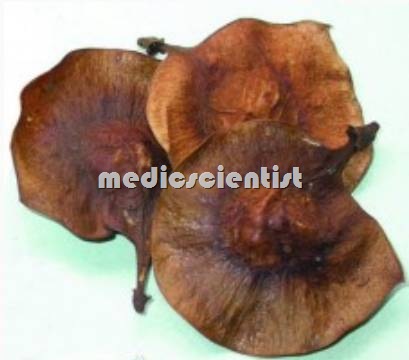Bijaka ASANA (Heart wood)
Asana consists of heart-wood of Pterocarpus marsupium Roxb. (Fam. Leguminosae); a moderate to large sized, deciduous tree, upto 30 m high and 2.5 m in girth, with straight clear bole, Brown to chocolate colour, under microscope shows vessels with bordered pits, fibre tracheids, tracheids, fragments of xylem rays and few crystal fibres, starch absent.
- found mostly throughout Gujarat, Madhya Pradesh, Bihar and Orissa.
Scientific classification
- Kingdom: Plantae
- (unranked): Angiosperms
- (unranked): Eudicots
- (unranked): Rosids
- Order: Fabales
- Family: Fabaceae
- Subfamily: Faboideae
- Tribe: Dalbergieae
- Genus: Pterocarpus
- Species: P. marsupium
- Binomial name — Pterocarpus marsupium
SYNONYMS ASANA (Heart wood)
- Sanskrit : Bijaka, Pitasira, Asanaka, Bijasara
- Hindi : Vijayasara, Bija
- Assamese : Aajar
- Bengali : Piyasala, Pitasala
- English : Indian Kino Tree
- Gujrati : Biyo
- Marathi : Bibala
- Oriya : Piashala
- Punjabi : Chandan Lal, Channanlal
- Tamil : Vengai
- Telugu : Yegi, Vegisa
- Urdu : Bijasar
- Kannada : Bijasara, Asana
- Kashmiri : Lal Chandeur
- Malayalam : Venga
DESCRIPTION and PLACES OF ORIGIN
- found mostly throughout Gujarat, Madhya Pradesh, Bihar and Orissa.
- Drug occurs as irregular pieces in variable size and thickness, golden yellowish-brown with darker streaks, on soaking
- in water gives yellow colour solution with blue fluorescence very hard, moderately heavy, strong, tough, fracture, difficult to break but brittle, taste, astringent. Transverse section shows alternating bands of larger and smaller polygonal cells consisting of tracheids,in singles or in groups of 2-3, showing tyloses filled with tannin;
- fibre tracheids, xylem parenchyma and traversed by xylem rays, numerous xylem vessels distributed throughout,
- tracheids numerous, long, thick-walled with tapering ends and simple pits; fibre tracheids elongated, thick-walled with narrow lumen and simple pits;
- in isolated preparations, vessels, drum or barrel shaped with well-marked perforation rims and bordered pits;
- paratracheal, surrounding vessels; xylem rays uni-to-biseriate, 3-5-7 cells high, xylem parenchyma rectangular with simple pits, prismatic crystals of calcium oxalate present in crystal fibres, starch absent.
- Powder: Brown to chocolate colour, under microscope shows vessels with bordered pits, fibre tracheids, tracheids, fragments of xylem rays and few crystal fibres, starch absent.
CONSTITUENTS –
- Alkaloids and resin
PROPERTIES AND ACTION
- Rasa : Kasya, Katu, Tikta
- Guna : Laghu, Ruksa
- Virya : Ushna
- Vipaka : Katu
Function or Karma AYURVEDA
- Kaphapittashamaka,
- Galadosaghna, Keya,
- Tvacya, Stambhana,
- Kusthaghna,
- Rasayana,
- Raktasodhana
IMPORTANT FORMULATIONS –
- Nyagrodhadi Churan,
- Asanabilvadi Taila
THERAPEUTIC USES –
- Parts of the Indian Kino (heart wood, leaves, flowers) have long been used for their medicinal properties in Ayurveda.
- The heart wood is used as an astringent and in the treatment of inflammation and diabetes.
- Pandu,
- Prameha,
- Kusthr,
- Krmiroga
- Medodoshaya,
DOSE AYURVEDA DRUGS –
- 50-100 g of the drug for decoction




